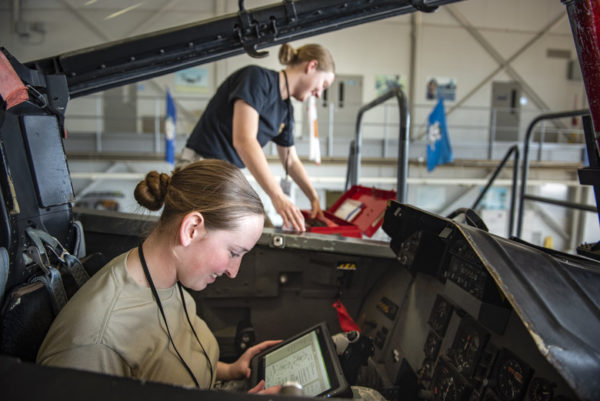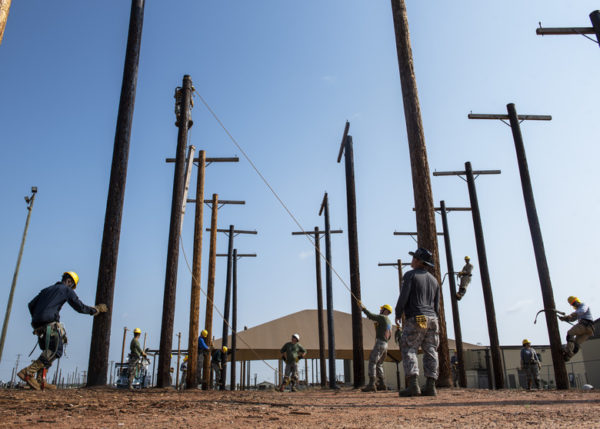As the Air Force continues to evolve to meet the challenges of a constantly evolving global security environment, the 82nd Training Wing is working to transform maintenance and logistics technical training.
About 44% of the Air Force’s technical training is accomplished at the 82nd Training Wing, said Kenyon Bell, 82nd Training Wing commander – which includes logistics and most engineering career fields. The 82nd delivers more than 65,000 graduates annually in more than 900 maintenance, logistics, civil engineering and some cyber and missile maintenance courses. These courses cover not only initial skills training, but advanced and specialty courses delivered at 60 locations around the globe.
“That includes logistics readiness; aircraft, munitions and missile maintenance; and civil engineering,” Bell said. “We have a significant role in training all of those disciplines, either entirely within the 82nd or in concert with our joint partners and also our sister wings in Second Air Force. That means we have a huge challenge and a huge opportunity – to transform technical training, and specifically maintenance and logistics training, to meet the strategic demands of a 21st Century force.”
Bell said the wing, Second Air Force and AETC have been laying the foundations for this transformation for several years.

Airman 1st Class Christine Smith and Airman 1st Class Kaylie Cunningham, 364th Training Squadron electrical and environmental apprentice course students, remove and install an oxygen regulator on an F-15 Eagle at Sheppard Air Force Base, Texas. U.S. Air Force photos by Airman 1st Class Pedro Tenorio.
“There has been a lot of experimentation and innovation going on, especially since 2016,” he said. “It’s been incredibly important in helping us understand what works and what doesn’t. Now it’s time to start putting those lessons in play.”
Among those experiments are efforts like the Enhanced Training Day, launched at Sheppard Air Force Base in 2016. That effort explored ways to incorporate force development and foundational competencies – Airmanship – into the technical training environment. Along with similar efforts at other technical training wings, the experiment helped inform Second Air Force’s Airmanship 200 program, which will formally integrate core Airmanship and force-development concepts into technical training beginning this year.
Another effort more specific to the maintenance and logistics world is Maintenance Next. Activated in January 2019 at Joint Base San Antonio’s Kelly Field, its goal is to explore ways to leverage advanced technologies to train aircraft maintainers – specifically crew chiefs – more efficiently and effectively.
“Technology is changing the way we live and learn and it has opened up many opportunities to improve training to meet the needs of today’s airman,” said Lt. Col. Sean Goode, Maintenance Next detachment commander.
Currently, the Maintenance Next team is working with students who recently graduated basic military training. These students are able to explore through learning labs any time of the day or night in their dormitory or work center. The labs feature a variety of learning devices to include augmented and virtual-reality simulators.

366th Training Squadron electrical systems apprentice course students perform a crossarm change out at Sheppard Air Force Base, Texas.
“Offering 24/7 access to education and diverse tools helps our team understand which tools best suit the learning needs of our airmen,” Goode said. “We are also examining those tools to determine if they are successful at building maintainer competencies through hands-on evaluations.”
Beginning this spring, Maintenance Next will be field tested at Sheppard AFB, Bell said. “The next step is to test them in the formal training environment. If we get the results we expect, then we’ll focus on the next big challenge – how to implement across other maintenance specialties and then sustain it.”
While transforming maintenance and logistics training is a strategic imperative, Bell said it’s important to be realistic.
This maintenance training transformation effort is a large job and will require coordination and cooperation across the enterprise: from the staff sergeant instructor at the podium all the way up to Air Education and Training Command commander, Lt. Gen. Brad Webb and Air Force deputy chief of staff for Logistics, Engineering and Force Protection, Lt. Gen. Warren Berry.
“Vision 2020 is our effort to make sure our stakeholders know what we’re trying to do and why – and also to get their input, support and buy-in,” Bell said. “It’s going to take all of us working together to make this happen.”
